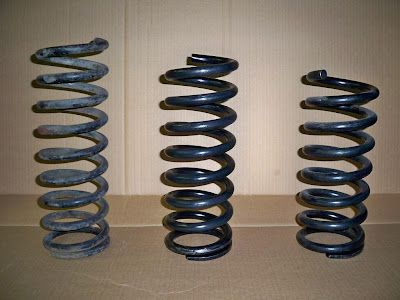The coil springs originally installed in my Mustang held the vehicle 10.5" up and were rated at 269 lbs/in. These springs are not the best for a performance application so most replace them when rebuilding the suspension.
I reviewed the options available from the various suppliers but did not like the offerings. The two main offerings are a 550 lb and 620 lb spring. Most of these are designed to lower the vehicle about 1". From those I've spoke with the 620 lb springs can result in a rough ride on uneven streets. Regardless of the selection, these springs are all twice as stiff as stock.
I found a supplier who sells the springs from the Heavy Duty Suspension package offerred on '68 coupes. These held the vehicle 11" up and are rated at 428 lbs/in. I purchased these and cut 3/4 coil off which should put the ride height at about 10.25". This will likely not be the final height but I can cut further if needed. This will put me at a decent height until I decide on the wheels I will use. Cutting 3/4 of a coil of will raise the spring rate some but it will not exceed 450 lb which should give a nice ride with an increase in performance.
The picture below shows (from left to right) the original spring, HD spring, and a cut HD spring. After cutting some off each new spring, I painted them in the Chassis Black paint I have and put them aside for installation later.

I reviewed the options available from the various suppliers but did not like the offerings. The two main offerings are a 550 lb and 620 lb spring. Most of these are designed to lower the vehicle about 1". From those I've spoke with the 620 lb springs can result in a rough ride on uneven streets. Regardless of the selection, these springs are all twice as stiff as stock.
I found a supplier who sells the springs from the Heavy Duty Suspension package offerred on '68 coupes. These held the vehicle 11" up and are rated at 428 lbs/in. I purchased these and cut 3/4 coil off which should put the ride height at about 10.25". This will likely not be the final height but I can cut further if needed. This will put me at a decent height until I decide on the wheels I will use. Cutting 3/4 of a coil of will raise the spring rate some but it will not exceed 450 lb which should give a nice ride with an increase in performance.
The picture below shows (from left to right) the original spring, HD spring, and a cut HD spring. After cutting some off each new spring, I painted them in the Chassis Black paint I have and put them aside for installation later.











